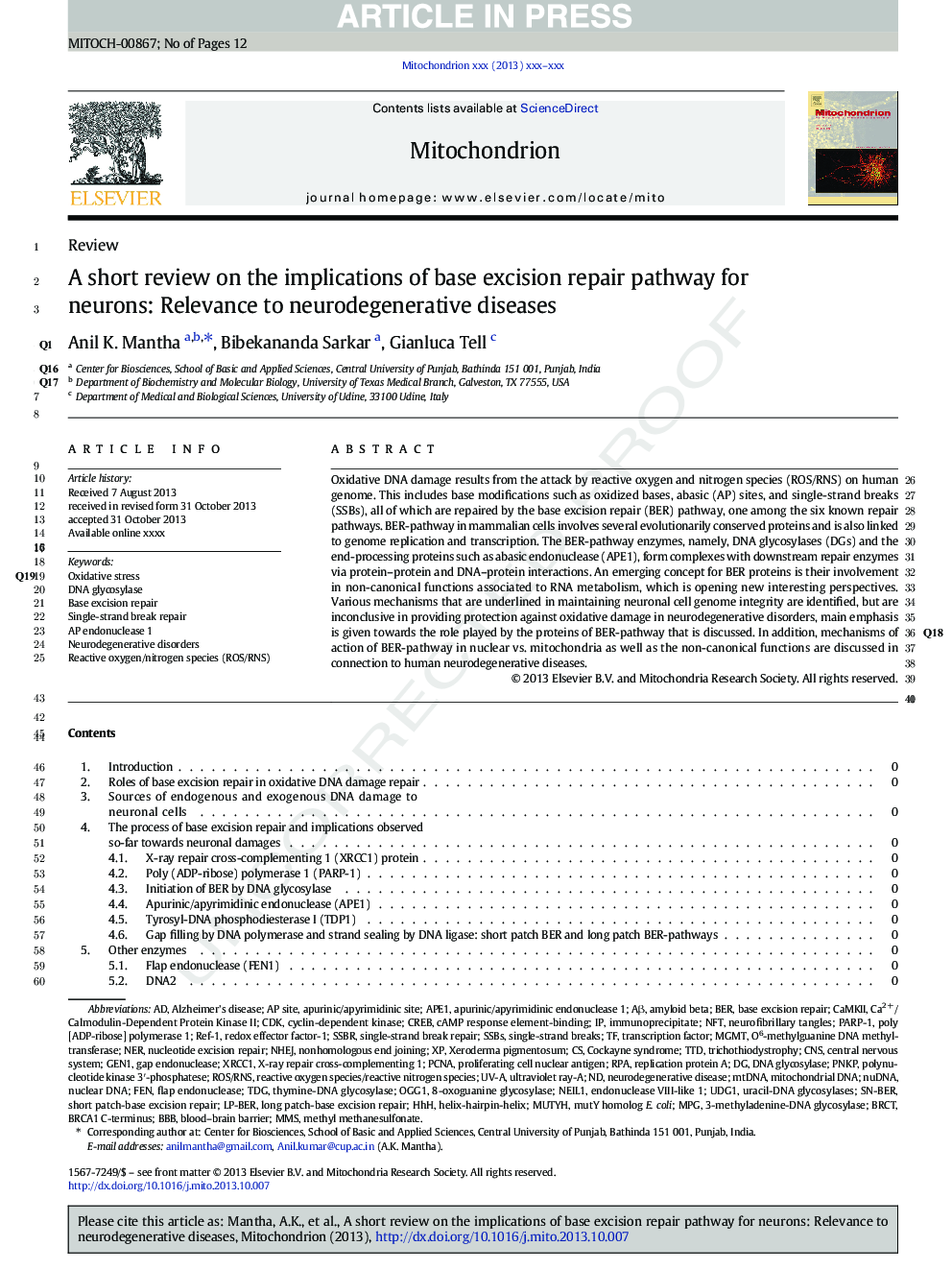| کد مقاله | کد نشریه | سال انتشار | مقاله انگلیسی | نسخه تمام متن |
|---|---|---|---|---|
| 8399528 | 1544427 | 2014 | 12 صفحه PDF | دانلود رایگان |
عنوان انگلیسی مقاله ISI
A short review on the implications of base excision repair pathway for neurons: Relevance to neurodegenerative diseases
ترجمه فارسی عنوان
بررسی کوتاه در مورد پیامدهای مسیر اصلاح پایه برای نورون: مربوط به بیماری های نوروژنیک
دانلود مقاله + سفارش ترجمه
دانلود مقاله ISI انگلیسی
رایگان برای ایرانیان
کلمات کلیدی
BRCA1 C-terminusHHHMMSImmunoprecipitateRPAOGG1MPGpoly [ADP-ribose] polymerase 1BRCTAPE1XRCC1Ref-1SSBRCREBAP endonuclease 1NEIL1TDG8-Oxoguanine glycosylasenuDNAPCNAThymine-DNA glycosylaseLP-BERGEN1endonuclease VIII-like 1PNKPhelix-hairpin-helixNFTCDKPARP-1UV-ATTDMGMTAβBERCaMKIINHEJapurinic/apyrimidinic endonuclease 1 - apurinic / apyrimidinic endonuclease 1apurinic/apyrimidinic site - apurinic / apyrimidinic سایتCa2 +/calmodulin-dependent protein kinase II - Ca2 + / calmodulin وابسته پروتئین کیناز IIMitochondrial DNA - DNA میتوکندریاNuclear DNA - DNA هسته ایDNA glycosylase - DNA گلیکوزیلازNER - DOWNxeroderma pigmentosum - pigmentosum xerodermaROS/RNS - ROS / RNSSSBs - SSBtrichothiodystrophy - TrichothiodystrophyProliferating Cell Nuclear Antigen - آنتیژن هسته ای تکثیر سلولیNeurodegenerative disorders - اختلالات نوروژنیکcAMP response element-binding - الگوریتم پاسخ cAMPamyloid beta - بتا آمیلوئیدAlzheimer's disease - بیماری آلزایمرNeurodegenerative disease - بیماری های نوروژنیکnucleotide excision repair - تعمیر مجدد نوکلئوتیدیbase excision repair - تعمیر پایه پایهsingle-strand break repair - تعمیر یک بار راندینگreplication protein A - تلقیح پروتئین AOxidative stress - تنش اکسیداتیوCNS - دستگاه عصبی مرکزیO6-Methylguanine DNA Methyltransferase - دی اکسید متیل ترانسفراز دی اکسیدیلینmtDNA - دیانای میتوکندریاییAP site - سایت APBBB - سد خونی مغزیBlood–brain barrier - سد خونی مغزیCockayne syndrome - سکته Cockaynecentral nervous system - سیستم عصبی مرکزیsingle-strand breaks - شکاف تک رشته ایTranscription factor - عامل رونویسیFlap endonuclease - فلاپ آندونوکراسیFen - فینmethyl methanesulfonate - متیل متان سولفوناتMUTYH - موتیفneurofibrillary tangles - مگس های نوروفیبریلیالNonhomologous end joining - پیوستن به انتهای غیرخطیcyclin-dependent kinase - کییناز وابسته به سیکلین
موضوعات مرتبط
علوم زیستی و بیوفناوری
بیوشیمی، ژنتیک و زیست شناسی مولکولی
بیوفیزیک
چکیده انگلیسی
Oxidative DNA damage results from the attack by reactive oxygen and nitrogen species (ROS/RNS) on human genome. This includes base modifications such as oxidized bases, abasic (AP) sites, and single-strand breaks (SSBs), all of which are repaired by the base excision repair (BER) pathway, one among the six known repair pathways. BER-pathway in mammalian cells involves several evolutionarily conserved proteins and is also linked to genome replication and transcription. The BER-pathway enzymes, namely, DNA glycosylases (DGs) and the end-processing proteins such as abasic endonuclease (APE1), form complexes with downstream repair enzymes via protein-protein and DNA-protein interactions. An emerging concept for BER proteins is their involvement in non-canonical functions associated to RNA metabolism, which is opening new interesting perspectives. Various mechanisms that are underlined in maintaining neuronal cell genome integrity are identified, but are inconclusive in providing protection against oxidative damage in neurodegenerative disorders, main emphasis is given towards the role played by the proteins of BER-pathway that is discussed. In addition, mechanisms of action of BER-pathway in nuclear vs. mitochondria as well as the non-canonical functions are discussed in connection to human neurodegenerative diseases.
ناشر
Database: Elsevier - ScienceDirect (ساینس دایرکت)
Journal: Mitochondrion - Volume 16, May 2014, Pages 38-49
Journal: Mitochondrion - Volume 16, May 2014, Pages 38-49
نویسندگان
Anil K. Mantha, Bibekananda Sarkar, Gianluca Tell,
